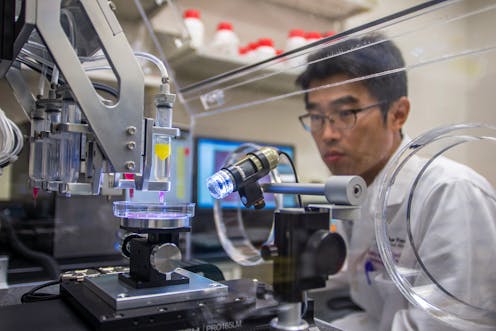Proposed new regulations for 3D printed medical devices must go further
- Written by Richard Matthews, PhD Candidate, University of Adelaide

3D printing has rapidly increased in quality and popularity over the past decade. In the medical sector, it has evolved from the creation of relatively simple prosthetics, to a silicon prototype of a functioning human heart.
Unfortunately regulation hasn’t kept pace with technological progress.
As the costs of 3D printing have reduced and new filament options have become available, patients are now able to manufacture their own prosthetics at home – or school – under the “custom made” definition of the Therapeutic Goods Administration frameworks. Soon we will be able to print our own medicines.
Read more: Explainer: what is 3D printing and what's it for?
But who should be legally responsible as the manufacturer when 3D printed devices fail?
In what could serve as a watershed moment for additive manufacturing, the TGA is now proposing changes to the personalised and 3D printed medical devices regulatory framework that have the potential to settle that question.
Access versus safety
In January 2013, the US medical device company, DePuy, recalled their knee and hip replacement systems. The devices were made from layers of metal, and shavings had come loose – potentially harming the patient. There is a high possibility of similar problems occurring (called layer separation) in 3D printed parts.
The TGA’s proposed amendments are part of an effort to increase oversight and prevent these kinds of issues. In doing so, the TGA must balance ease of access for patients with the need to protect the public from the harm posed by devices that are manufactured without adequate oversight and testing. All this within a medical system already under pressure financially.
Read more: 3D printers: A revolutionary frontier for medicine
The current TGA framework breaks therapeutic goods into three areas: medicines, biologicals and medical devices.
Medicines are the pharmacological items we get from a chemist and biologicals are anything containing human cells.
Medical devices are ranked on a scale from Class I to Class III according to the level of harm they may pose to a patient. These devices are already subject to strict regulation and range from eye glasses (Class I) to custom vascular stents (Class III).
The “custom made” exemption
While a 3D printed prosthetic may be classified as Class I, or low risk, the technology has progressed to enable more advanced implants and tools to be produced that encompass Class III, or high risk, medical devices.
For example, full surgical intrument sets for space missions, umbilical cord clamps for disaster relief efforts and new implantable medical devices to help heal fractured bones.
If such devices are mass produced on a 3D printer, then high level, third party oversight of safety, quality and performance applies. However, if they fall under the custom made definition, third party oversight does not apply.
Devices made for a specific patient under the current framework are considered under the “custom made” definition. Historically, this made sense since custom made items were typically low risk and few in number. But as the number and complexity of custom made devices grows, we need to ensure they are subject to the same high level scrutiny as mass produced devices.
Shifting definitions
The custom made loophole isn’t the only issue with the current framework. There remains an ambiguity about who is legally responsible for the manufacture of a device.
Under the existing rules,
“it is important to note that the person who adapts a medical device for an individual patient is not considered to be a manufacturer of a medical device if the adaptation does not alter its intended purpose… However, the device that requires modification is also required to be included on the Australian Register of Therapeutic Goods (ARTG) before it is supplied.”
This is fine for items such as the raw material used for making dental crowns.
But what about TGA approved filaments and other raw materials for 3D printing?
There is a risk that once raw materials are approved and included on the ARTG then any device could be printed and circumvent the definition of being a manufacturer.
For example, if a filament impregnated with copper was approved, we could print a custom made copper IUD contraceptive based on 3D scans similar in concept to this already open source device. Given personal scans of the patient were integrated into the design it would meet the custom made definition, so paperwork related to it would only be required to be kept for five years. But a copper IUD can last anywhere from five to 12 years. Therefore, the risk of such a device causing permanent infertility would not be properly managed.
Who is the manufacturer?
This is proposed to be changed by including the following addition in the framework:
“…the assembly or adaptation must be in accordance with validated instructions provided by the manufacturer of the device to be adapted; and that, if an individual modifies a device … in such a way that compliance with the essential principles may be affected, they shall assume the obligations incumbent on manufacturers…”
This goes some way towards fixing the problem.
But if a hospital were to print devices for their patients by strictly following the instructions from the supplier, they would not be considered the manufacturer under this change.
So who would be responsible for the device? How do we treat the designs of products and their associated 3D files – the digital blueprints of a medical device?
Traditional definitions of manufacture do not encompass the designer. Generally speaking, we assume the business that designs an item will manufacture the item. That is not always going to be the case with the democratisation of 3D printing technology.
Read more: Speaking with: Mia Woodruff about using 3D printing to replace body parts
Future regulation
I have previously written about the Australian laws surrounding 3D Printed Firearms. I drew the conclusion that we need a unified approach to legislation that specifically speaks to the capabilities of 3D printers, and the digital blueprints devices are based on.
The TGA is beginning to address this by ensuring items that are now enabled by this technology are suitably captured by the existing legislation. What still isn’t clear is how digital blueprints will be treated in this new age of fabrication.
Comments submitted during the consultation process of the regulatory changes are now being reviewed by the TGA. If the TGA is serious about preventing harms caused by 3D medical devices, they must ensure these loopholes are closed.
Authors: Richard Matthews, PhD Candidate, University of Adelaide



















